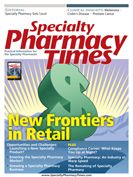Publication
Article
Specialty Pharmacy Times
Value of Independence Through Self-Administration
For patients who seek independence with infusion therapy, specialty nurses play an important role in promoting self-reliance and adherence.
For patients who seek independence with infusion therapy, specialty nurses play an important role in promoting self-reliance and adherence.
Providing infusion therapy in the home care setting can be challenging as well as beneficial, especially if the goal is to assist the client in achieving independence.
When thinking about independence, several nursing theories come to mind which can serve as a basis for implementation of a nursing plan of care with self-administration of infusion therapy. For example, Dorothy Orem’s Self Care Deficit Theory promotes the belief that “People should be self-reliant and responsible for their care…†and she further states that “Self-care is a practice of activities that an individual initiates and performs on his or her own behalf to maintain life, health and well being.â€1
Certainly in teaching clients to become independent with their infusion regimen, recognition of practices to promote and maintain life, health and well being is paramount for a client to begin to learn the steps involved with infusion therapy as well as understand their disease state, which correlates to compliance with medication administration. As nurses we stress the importance of health and prevention as well as promotion of independence. According to Virginia Henderson’s Needs Theory, the definition of nursing states: “ The nurse does for others what they would do for themselves if they had the strength the will and the knowledge…the nurse makes the patient independent of him or her as soon as possible.â€2
Furthermore, in Henderson’s The Nature of Nursing, the role of the nurse is “to get inside of the patient’s skin and supplement his strength will or knowledge according to his needs. The nurse has the responsibility to assess the needs of the patient, help him or her meet health needs, and provide an environment in which the patient can perform activity unaided.â€
When these nursing theories where being developed and implemented, Dr. Orem and Dr. Henderson had no inclination as to the extent to which nursing would evolve, especially in the field of home infusion therapy. If they were around today they would be proud to see nursing using their theories to develop plans of care that assist clients to achieve the highest level of independence in the management of their disease state related to home infusion therapy.
It is difficult to measure the value of independence. A review of literature yielded minimal research or outcomes. Clients with chronic disease states have claimed that their disease process can incapacitate them greater than 50 days a year, causing them to lose their jobs or not be able to complete their education. In addition to the disease process, they need additional time off to be available to receive their infusion therapy in a medical facility or physician office. One can surmise that if a client where to achieve independence with self infusion it would be of value—no nursing visits, ability to control when and where to infuse, control over their disease management, as well as deciding where to insert their own IV catheter.
Some home infusion companies have acknowledged the benefit to be able to measure the value of independence through outcome research. They have collected data from clients evaluating their experience with being taught how to self-infuse and can extrapolate client’s perception of what independence means to them. Additional research and outcome data would be valuable to evaluate the expected outcomes of clients currently being taught self-administration, and to support the growing need for clients to adhere to their therapy by achieving independence in both their disease state and treatment.
References
1. Nursing Theory-Orem’s Self-Care Deficit Theory. (n.d.). Retrieved from http://nursing-theory.org
2. Nursing Theory-Pender’s Health Promotion Model. (n.d.). Retrieved from http://nursing-theory.org
About the AuthorsCherylann Gregory, RN, BSN, is founder and president of the Specialty Pharmacy Nursing Network (SPNN). She has more than 30 years of experience as an oncology/infusion nurse and combines her clinical knowledge with an entrepreneurial spirit. SPNN is one of the first specialty pharmacy nursing services to provide a nationwide network of 500 qualified nurses to meet the needs of specialty pharmacies and biotech manufacturers. The organization’s services include coordination of care, drug administration, first dosing, education, clinical outcome data collection and reporting, and on-call coverage for specialty therapies. For more information visit www.spnninc.com.Virginia Strootman RN, MS, CRNI, has been a nurse for more than 24 years and is currently a clinical resource nurse. She provides educational programs to health care practitioners involved with administration of biologics and patient education and is a member of the INS Nursing Network.







